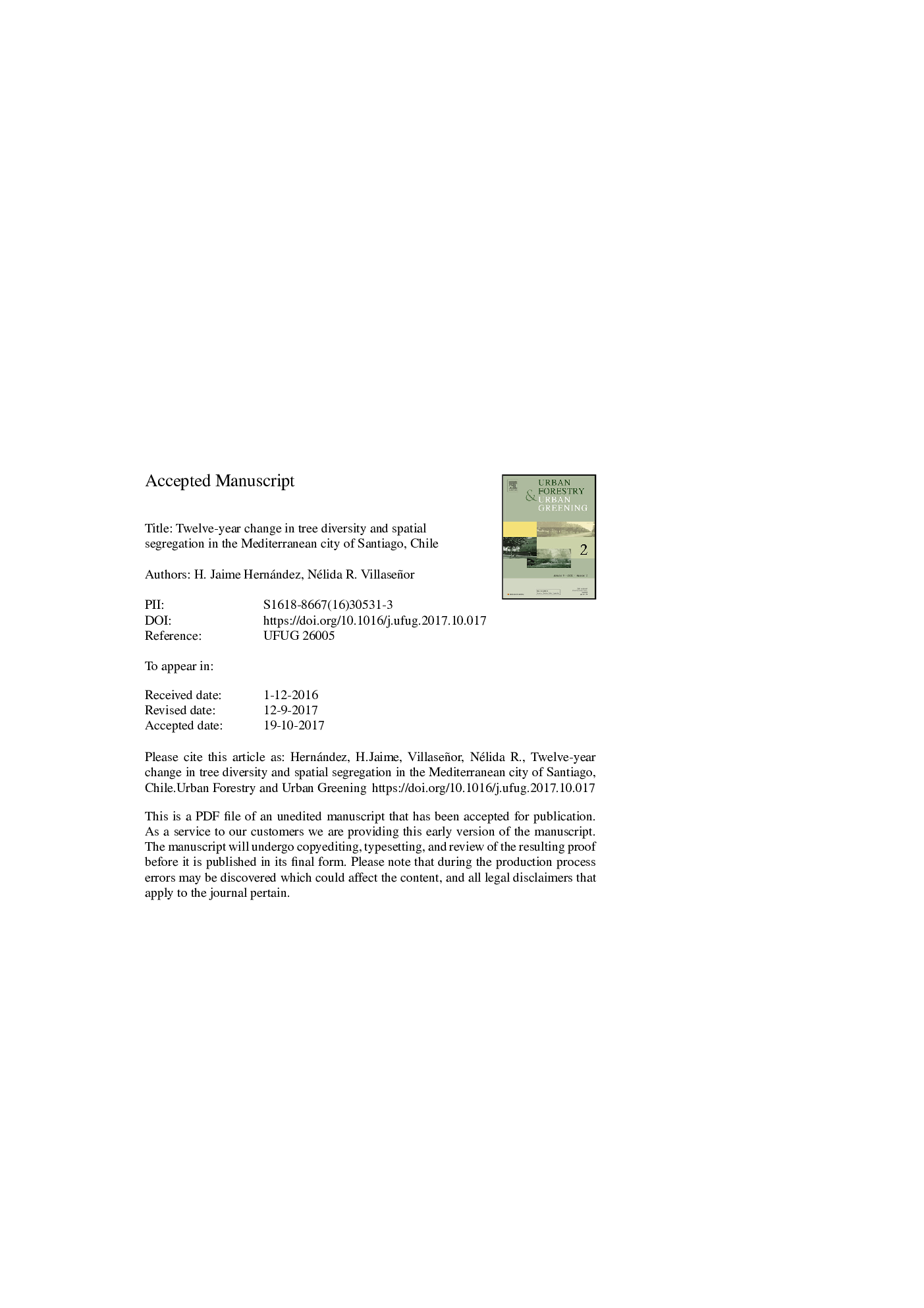| کد مقاله | کد نشریه | سال انتشار | مقاله انگلیسی | نسخه تمام متن |
|---|---|---|---|---|
| 6549372 | 1421861 | 2018 | 42 صفحه PDF | دانلود رایگان |
عنوان انگلیسی مقاله ISI
Twelve-year change in tree diversity and spatial segregation in the Mediterranean city of Santiago, Chile
ترجمه فارسی عنوان
تغییرات دوازده ساله در تنوع درختان و جدایی فضایی در شهر مدیترانه سانتیاگو، شیلی
دانلود مقاله + سفارش ترجمه
دانلود مقاله ISI انگلیسی
رایگان برای ایرانیان
کلمات کلیدی
همگن سازی زیستی، نقطه نقطه، تراکم درخت، جداسازی زیست محیطی شهری، جنگل شهری، زندگی گیاهی،
ترجمه چکیده
تنوع درخت یکی از مهمترین اجزای اکوسیستم های شهری است، زیرا مزایای زیست محیطی چندگانه را فراهم می کند و به رفاه انسان ها کمک می کند. با این حال، توزیع درختان شهری ممکن است به صورت فضایی جدا و در طول زمان تغییر کند. برای ارائه بینش برای توزیع بهتر تنوع درختان در یک شهر اجتماعی به طور جداگانه، تفکیک فضایی در فراوانی و تنوع درختان را بر اساس گروه اجتماعی اجتماعی و تغییر آنها در یک دوره 12 ساله در سانتیاگو شیلی ارزیابی کردیم. در سالهای 2002 و 2014 در سراسر سانتیاگو دو صد قطعه گیاهان در سراسر سانتیاگو نمونه برداری شد. ما دریافتیم که فراوانی و تنوع درختان شهری برای کل شهر در طول 12 سال پایدار بوده است، در حالیکه گونه و گونه های گونه های بومی گونه افزایش یافته است. با توجه به غنای گونه ای و فراوانی گونه ها به وسیله گروه اجتماعی اجتماعی، بخش های ثروتمند دارای گونه های بیشتری و فراوانی درختان (برای همه گونه های درختی و گونه های بومی) نسبت به فقرا وجود دارد. ترکیب و ساختار جامعه درختی با گروه اجتماعی-اقتصادی متفاوت بود، اما هیچ مدرکی مبنی بر افزایش همگن سازی جنگل شهری در آن 12 سال یافت نشد. یافته های ما نشان داد که هرچند تنوع و فراوانی درخت برای کل شهر در دوره 12 ساله ما تغییر نکرده بود، از نظر اجتماعی و اقتصادی، نابرابری های فراوانی و تنوع درختان شهری وجود داشت. با توجه به این که 43 درصد از خانه ها در سانتیاگو در مناطق اجتماعی و اقتصادی پایین تر هستند، مطالعه ما اهمیت هدف قرار دادن کاشت درختان، نگهداری و برنامه های آموزشی در این مناطق را برای کاهش نابرابری در توزیع درخت ها برجسته می کند.
موضوعات مرتبط
علوم زیستی و بیوفناوری
علوم کشاورزی و بیولوژیک
جنگلداری
چکیده انگلیسی
Tree diversity is one of the most important components of urban ecosystems, because it provides multiple ecological benefits and contributes to human well-being. However, the distribution of urban trees may be spatially segregated and change over time. To provide insights for a better distribution of tree diversity in a socially segregated city, we evaluated spatial segregation in the abundance and diversity of trees by socioeconomic group and their change over a 12-year period in Santiago, Chile. Two hundred vegetation plots were sampled across Santiago in 2002 and 2014. We found that overall abundance and diversity of urban trees for the entire city were stable over 12 years, whereas species richness and abundance of native tree species increased. There was segregation in tree species richness and abundance by socioeconomic group, with wealthier areas having more species and greater abundance of trees (for all tree species and native species) than poorer ones. Tree community composition and structure varied with socioeconomic group, but we found no evidence of increased homogenization of the urban forest in that 12 years. Our findings revealed that although tree diversity and abundance for the entire city did not change in our 12-year period, there were important inequities in abundance and diversity of urban trees by socioeconomic group. Given that 43% of homes in Santiago are in the lower socioeconomic areas, our study highlights the importance of targeting tree planting, maintenance and educational programs in these areas to reduce inequalities in the distribution of trees.
ناشر
Database: Elsevier - ScienceDirect (ساینس دایرکت)
Journal: Urban Forestry & Urban Greening - Volume 29, January 2018, Pages 10-18
Journal: Urban Forestry & Urban Greening - Volume 29, January 2018, Pages 10-18
نویسندگان
H. Jaime Hernández, Nélida R. Villaseñor,
